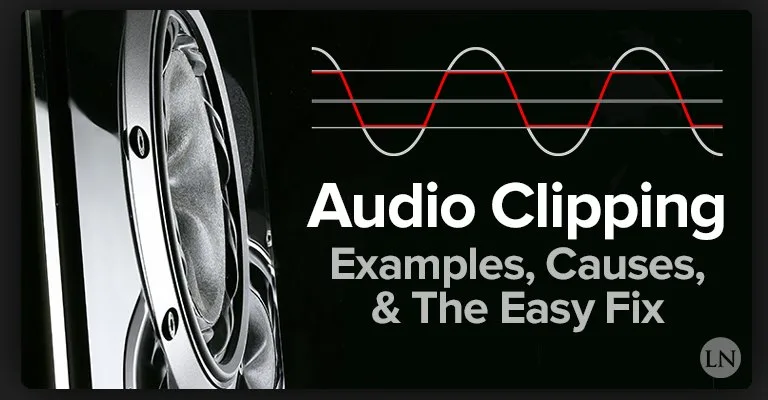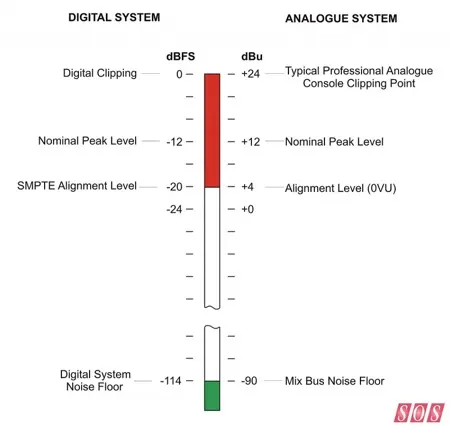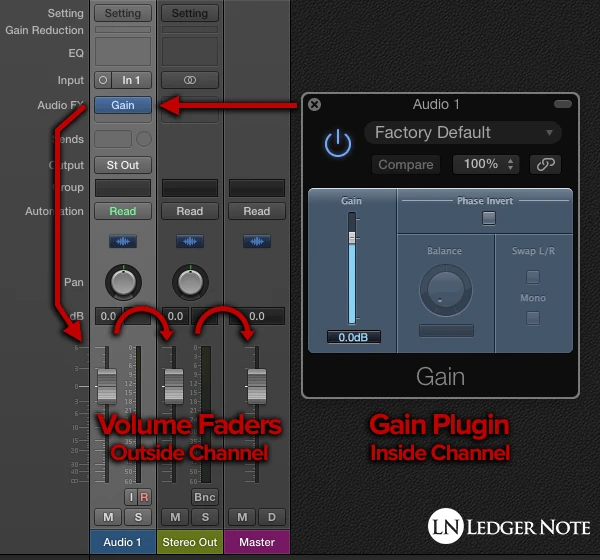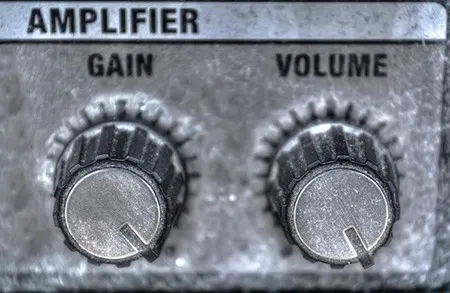
Whether during recording or playback, you’ve been around someone that sees the little red light go off or light up permanently who then says “Oh, dude, you’re clipping.” But do they even know what audio clipping is?
What causes clipping? Is there anything we can do about it? Is it the same as peaking (yes)? I’m going to explain it all, tell you what it sounds like, and show you how to fix it.
It’s important if you want to get the full enjoyment and experience out of any music, TV, or movies you’re trying to enjoy. This audio peaking can undermine your expensive entertainment system, high quality headphones, and studio monitor speakers, so let’s get this fixed up for you, pronto.
What is Audio Clipping?
Clipping audio is when an audio signal is amplified past the maximum allowed limit, whether in a digital or analog system. This is called ‘overdrive’ and just like the guitar pedals with the same name, it leads to distortion and a lowering of audio quality.

It’s called clipping because that’s what the clipping waveform ends up looking like. A smooth, rounded sine wave has its peaks and troughs ‘clipped off,’ resulting in the flat plateau of a square wave. When this plateau is played back in your loudspeaker, it’s an unnatural and jarring event that sounds horrible and can even lead to blown speakers.
What Does Audio Clipping Sound Like?
Clipping is the phenomenon that causes the sound of distortion. You hear distortion in rock and heavy metal guitars all of the time, but that’s done purposefully and tastefully. We actually have terms in the music industry for the three levels of distortion:
- Overdrive
- Distortion
- Fuzz
All three levels are noticeable, but they’re really obvious in the 2nd and 3rd levels. Overdrive is the lightest amount of distortion and can even be unnoticeable. Distortion is when you start to notice the audio is ‘breaking up’ and losing quality.
Fuzz sounds like a bunch of bees in a plastic bag frantically trying to get out. The difference between a purposefully distorted guitar versus accidental clipping is that it affects the entire audio track and sounds horrible.

The picture above is the visual, graphical version of the results of distortion. You lose detail and resolution, and things stop sounding clear and sharp, while you also end up with unwanted noise, hiss, clicks, pops, and other sounds that aren’t in the original audio.
Why Do We Care About Audio Clipping?
There are not only different types of audio clipping but there’s also ranges of severity. Almost every professionally recorded, mixed, and mastered piece of audio you hear has clipping audio built into it on purpose.
That’s because you can have minor amounts of peaking that aren’t noticeable but give you more ‘headroom’ in order to let you have a louder audio source. But when you have major amounts of peaking audio you’ll definitely hear it. In some cases it can do damage to your listening equipment too.
You’ll know when you have severe clipping because you’ll hear it. It sounds like the audio is starting to ‘break up,’ which is light distortion. The more severe it is, the more distorted the music begins to sound until it can become unrecognizable in an ocean of noise and loudness.
The reason we care, beyond it sounding bad, is that our speakers have physical components that react to the audio signal. In electronics, volume is directly associated with the amount of voltage you’re sending through, and higher voltage means higher temperatures.
If you allow your speakers to clip long enough, they can experience overheating and damage to the coils. Because the woofers vibrate to reproduce sound, the clipped off portions can cause a jarring movement that can ultimately rip the fabric of the cone or tear it away from the sides.
Why Does Audio Clipping Occur?
Clipping can occur at any stage of your audio signal path. With analog clipping, you can peak at the microphone, the preamplifier, the analog-to-digital converters, digitally in your computer, at the amplifier, and at the speakers. With digital clipping that can be at the converters, a plugin, any software, or the master output. Every piece of equipment has the ability to be over-driven.
This is because each piece of equipment has a correct volume range it is meant to operate in. If you go too loud at any stage, you can introduce peaking. This is why you find so many volume knobs and gain knobs when you’re working with audio. You’re meant to adjust the volume to the right levels at each stage.

This gets confusing due to the three different scales used but we have to mention them to fully understand the topic. Decibels is abbreviated as dB. These scales are:
- dBFS (decibels full scale, digital)
- dBu (decibels unloaded, analog)
- VU (voltage units, electrical)
For instance, analog equipment has a maximum voltage it can handle, described as +24 dBu or 20 VU, and moving toward zero and then into the negative as you get quieter. Anything past this maximum is literally clipped off. In digital systems this maximum number is 0 dBFS until the bits of each sample are completely full of information (called ‘saturation’).

The correct levels that each piece of equipment is designed to handle is around +4 dBu, 0 VU, and -18 dBFS. So the reason audio clipping occurs is because somewhere along the line, the amplitude (volume) of the audio is higher than those allowed limits and is peaking.
How Do We Prevent Sound Clipping?
The main thing to understand is that once you have clipping audio at any early stage of your playback chain, it will sound distorted in any future part no matter if you set the correct levels or not.
An example of this is the popular VLC software for playing music and movies on the computer. It allows you to turn up the volume to 200% and higher. You can set your speakers to be very quiet and then turn up the volume in VLC extremely high and have clipping audio coming out of your speakers at very low volumes.

This is called gain staging and is how you stop clipping and make sure it never happens again. There’s a big difference between gain vs. volume, so I suggest reading both of those articles if you want a deep dive. Otherwise I have the simple explanations below.
How to Stop Audio Peaking When It’s Too Late
So the first question is, what can we do once it’s too late like this? This won’t be relevant to anyone not involved in the music industry or setting up a church sound system, but you’ll be happy to know that loudspeakers have protective circuits in them that cause the signal to ‘soft clip’ instead of ‘hard limit.’
Soft clipping takes that sharp plateau caused by clipping and rounds it off so that it takes a bit more of a smooth shape. This protects your speakers from overly unnatural movements that cause the tearing of the cones, but they can still suffer heat damage if the distortion is allowed to continue for prolonged amounts of time.
Your mixing console, digital audio workstation software, or amplifier has a ‘limiter’ on it that puts a preventative stop to peaking using dynamic range compression. You will still have clipping audio, but the voltage won’t be higher than the acceptable limits. You just end up with horrible sounding audio.
You can also use a compressor to reduce volumes without limiting, resulting in a more pleasant sound that helps defend you from clipping. Professional studio engineers often use a compressor and a limiter just in case. You may be asking what is a compressor and what is a limiter, in which case those links have you covered.
How to Stop Clipping Distortion at the Source
If you’re listening to television, movies, video games, or professionally released music, the source levels of audio will be high but won’t be so high as to cause sound clipping. They will have normalization applied, turning them up in volume as much as possible without peaking.
You should set any software levels to 100% or lower, but never higher. If you need more volume then you should turn up the volume at your speakers or headphones.
The same goes for playing guitar or keyboards or recording with a microphone. If you’re dealing with clipping in music, you should first turn down the gain at the instrument or preamplifier for the microphone. This ensures you’re not sending too hot of a signal to your amplifier or analog-to-digital converter.

The point is to make sure your source audio itself isn’t a hot signal that’s peaking. Then you move to the next piece of equipment and make sure its volume knob isn’t set too high. Follow this procedure all the way up through your receiver or amplifier and to your speakers. This works for studio recording, music clipping at venues, home entertainment system receivers, car amplifiers, and anything else.
Finally, typically with amplifiers (usually in the automotive audio) you can under-power or over-power your speakers. So try to make sure you’re using speakers that are matched for your amp’s power rating and vice versa. You can also introduce distortion simply by turning your speakers up louder than they can handle.
That’s Audio Clipping Defined, Explained, & Prevented
The basic cause of peaking is that somewhere along the line leading to your speakers or headphones, the audio signal has become too hot. That means it’s either too high in voltage (amplitude / volume) or it’s maxing out the bits at any digital stage.
You don’t need to know the technical details or be an electrical engineer to understand the basics or to fix it, though we provide that info above, too. Anything you need to know about audio clipping is here for you whenever you need it.